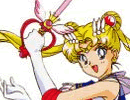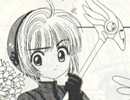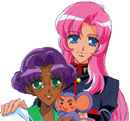|
A short skirt
and jewelry magically appears around the body of the pure and passionate
Sailor Moon. The inquisitive Miaka is magically transported to mystical
ancient China. Girls take up swords and become boys, and the most
beautiful of the beautiful boys fall in love with each other. And
yet in this ethereal world of enchantment, every day and in every
panel thousands of innocent young girls in sailor uniforms fall
in love and have their hearts broken. This is the world of girls'
manga (comic books) in Japan.
Tezuka Osamu,
the father of shounen (boys' ) manga, was also a pioneer of the
shoujo (girls') genre. His Ribon
no Kishi
(Knight of the Ribbon), written in 1953, was not the first
series targeted at girls, but it is regarded as the first series
that really incorporated many of the standard shoujo elements. This
series was filled with sophisticated stories that focused on love,
fantasy and drama, as were many of the series that followed. Male
artists would draw what they thought would appeal to female readers,
concentrating on making their stories emotional and their drawings
beautiful. By the late 1950s, shoujo manga was a recognized genre,
and in the early 1960s, comic magazines targeted at girls, such
as Shoujo Friend and Margaret, appeared. However,
it was some time before female artists started to write and draw
for shoujo magazines. In the 1960s, manga magazines went from being
monthy to being weekly, and there was a demand for more artists.
Therefore, women artists were able to break into the field. Today,
women artists dominate the shoujo manga industry.
There are many
forms, styles and cliches common to shoujo manga. As a rule, shoujo
manga emphasizes emotions, relationships and feelings, rather than
actions or situations. There is very little ugliness in shoujo manga;
everything is portrayed as sublimely beautiful, even controversial
topics such as incest, intercourse and homosexuality. Careful attention
is paid to little details such as the outfits the characters wear
and the way their hair is styled. The eyes are also generally the
most recognizable characteristic of a shoujo manga heroine; they
are huge, starry and feminine. While drama and romance are two of
the largest shoujo manga genres, they are not the only ones. There
are many subgenres of shoujo, from science fiction and fantasy to
mystery and horror. (Shoujo horror stories, as a matter of fact,
dominate the horror manga market.)
There are several
shoujo manga magazines that each appeal to different age groups
and personalities. Nakayoshi and Ribbon are targeted
towards girls under 6th grade, while Margaret, Lala
and Shoujo Comic are for teenagers. Reading Hana to Yume
might indicate that the reader is a bit of geek; reading Special
Edition Margaret might indicate more conservative, slightly
bland taste. There are also more recent magazines targeted at both
sexes. One named Duo had this as its slogan: "We reached
out for the same magazine at the same store, and that was our beginning
- Duo, for the two of us." While in America there are
very few comics specifically targeted at girls and female comic
book readers are in the minority, the Japanese shoujo comics are
read by most girls. There are about forty-five different magazines,
many with circulations well over a million.
Shoujo manga
and anime are becoming popular in the United States as well. Sailor
Moon became dazzlingly popular when it was aired in the United
States, and dedicated fans became a market for other shoujo titles
such as Fushigi
Yuugi
and Revolutionary
Girl Utena.
Shoujo is not as popular in the United States as shounen, but this
may be because translated shounen has received better distribution
around the world.
Shoujo manga
is ostensibly for girls. Yet after girls graduate, find jobs and
get married, they often still read the same manga they read as a
teenager. Also, guys enjoy shoujo, but out of embarrassment, they
often read it in secret. So even though shoujo manga might seem
at first glance to be sappy and overly dramatic, the appeal of a
good, emotional story is universal.
-Liana Sharer 
References
Frederik L. Schodt, Manga! Manga! The World of Japanese ComicsKodansha America, LTD, NY, NY 1983
Gilles Poitras, The Anime Companion, Stone Bridge Press, Berkeley, CA 1999
Card Captor Sakura
Sailor Moon
Fushugi Yuugi
Revolutionary Girl Utena
Matt Thorn, A History of Manga Part 3, http://www.ky.xaxon.ne.jp/~matt/history3.html, 1997
The Usenet Manga Glossary, 1998, http://www.landfield.com/faqs/manga/faq/
|
|

|
|
Usagi transforms
into Sailor Moon, ready to fight for love and justice.
|
|

|
|
This page
from Card Captor Sakura shows off one of the heroine's
charming outfits.
|
|

|
|
Utena, Anthy,
and Chu-Chu pose.
|
|















